310 Ear Examinations
AN EAR EXAMINATION
by David Hancock
 Type, or those characteristics which make a breed a breed, is not always easy to define unambiguously. But the ears, their shape, set and size, of a pure-bred dog can tell you in some cases which breed the dog belongs to. Basset Hounds, Bloodhounds and French scenthounds are expected to feature large ears but the terrier breeds rarely so. Spaniels usually have long ears but other gundog breeds: retrievers, setters and pointers do not. The flock guarding breeds, like the Maremma, the Anatolian Shepherd Dog and the Kuvasz, have neat unobtrusive ears, as have most of the spitz breeds. Experts within a breed can sometimes identify a dog's ancestry just by spotting some aspect of a dog's ears. As in many human families, the shape, set and size of ears in dog can quickly be identified as a matter of genetics.
Type, or those characteristics which make a breed a breed, is not always easy to define unambiguously. But the ears, their shape, set and size, of a pure-bred dog can tell you in some cases which breed the dog belongs to. Basset Hounds, Bloodhounds and French scenthounds are expected to feature large ears but the terrier breeds rarely so. Spaniels usually have long ears but other gundog breeds: retrievers, setters and pointers do not. The flock guarding breeds, like the Maremma, the Anatolian Shepherd Dog and the Kuvasz, have neat unobtrusive ears, as have most of the spitz breeds. Experts within a breed can sometimes identify a dog's ancestry just by spotting some aspect of a dog's ears. As in many human families, the shape, set and size of ears in dog can quickly be identified as a matter of genetics..jpg)
The breed standard, or word picture of a breed, usually attempts to describe the type of ear desired in each breed, for the guidance of breeders and judges. In these written standards it is not always easy to visualise what the words mean and the words are not always obeyed. The Mastiff, for example, is required by its breed standard to display small ears. I have never seen a Mastiff with small ears; most exhibits in the show ring feature quite large ears. The Basset Hound's ears are required to reach well beyond the muzzle but not excessively so. I see winning Basset Hounds with ears excessively, very much so, reaching well well beyond the muzzle.
What is the value of a standard if it is ignored by both judges and breeders? The breed standard of the Bloodhound and the Dachshund make no specification on length, in the latter that doesn't seem to matter but in the former it does. Giant ears may suit the elephant but have mainly nuisance value in the dog. The Beagles' ears are expected to be long, just like the Bloodhounds, but their length is wisely defined. A Beagles' ears should reach nearly to the end of its nose when drawn out or pulled forward. A Bloodhound's ears could reach the ground and still not breach the breed standard.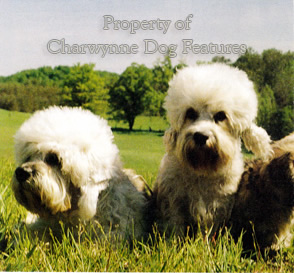
The Dandie Dinmont Terrier's standard needs over 140 words to describe the desired ear in the breed; that of the Cairn Terrier only 13. Over 2,000 Cairns were registered in 1999, only 100 Dandies. Perhaps Dandie breeders have given up trying to produce a 140-word ear! The standard of the Affenpinscher, in stark contrast to the Dandie's, is easy for any fancier to aim for: small, set high, either drop or erect. Are the ears of the Affenpinscher less important to their breeders than those of the Dandie to theirs? Of course not, common sense has prevailed. The value of a word-picture lies, not in volume, but in clarity.
The handsome Welsh Springer Spaniel is expected to have ears which are comparatively small but compared to what? Other spaniel breeds? The size of its head? This is hardly helpful. The splendid painting by Maud Earl of Champions Longmynd Myfanwy and Megan in 1906 show dogs with ears which are not small when compared with the dogs' heads but contribute to a balanced head. But if these words are not helpful, those used to describe the Bullmastiffs' ears, in its standard, are downright misleading. This standard demands ears 'folded back', which can only mean one thing: ears turned inside out! The American standard for the breed sensibly omits such foolish words. 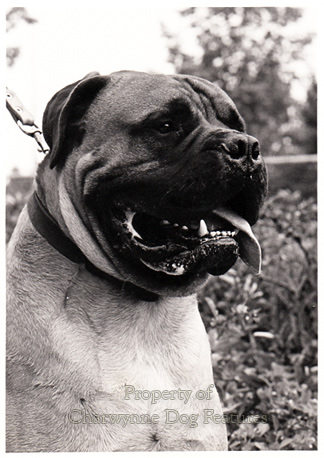
The Pekingese is required to have heart-shaped ears but how can anyone tell! I defy any judge to identify this desired feature. The Papillon is expected to have very large ears, unlike the Bloodhound and the Basset Hound, which both have ears which dwarf those of the Papillon, relative to size of skull. Who coordinates these standards? The Kennel Club and the British Veterinary Association have a Standing Committee which has set itself the task of looking at harmful wording in breed standards. Some years ago, a working party set up by this committee made a preliminary report which covered ears. This stated: Thick, heavy, low-set ears encourage a poor air circulation in the aural canal; while excessive hair in the canal although not mentioned in any standard does cause an enormous amount of aural irritation; it might therefore be sensible if those breeds in which it occurs made some mention of it as a fault in some way.
There are two disappointments in those words: firstly, the lack of a firm clear statement of action, and, secondly, the fact that they have never been implemented. Who's in charge? The Kennel Club owns the breed standards and the BVA has the UK veterinary mandate. Both have moral obligations. Who is safeguarding the well-being of pure-bred dogs? Weak advice is bad enough, spinelessness thereafter is disgraceful. Otitis (inflammation of the ear) is most common in flap-eared dogs such as spaniels where there is reduced ventilation of the ear canal. This committee has achieved no rewording of any breed standard on ears.
In some breed standards, the desired ear for the breed is described in terms which would not please the Plain English movement. Apparently a 'rose' ear is demanded in Bulldogs, but is defined as one: "folding inwards back, upper or front edge curving outwards and backwards, showing part of inside of burr." The burr being the prominent cartilage in the external ear canal of the Bulldog. Could you draw a Bulldog's ear from that description? The famous 'Philo-Kuon' description of a Bulldog of 1865, on which the original standard was based, uses these words to describe such an ear: "The 'Rose' ear falls backward, while the ends flap over outwards, exposing part of the inside." If you want the outer ear to protect the inner ear of the dog this is hardly the way to achieve it. This breed is listed (George M Strain's "Deafness in Dogs and Cats") as having a slight incidence of deafness.
In one breed standard, the desired ear for the breed is considered to be 'a unique feature of the breed', i.e. that of the Otterhound. The breed has to have ears featuring a "characteristic fold. Leading edge folding or rolling inwards giving curious draped appearance--an essential point not to be lost." Since the breed also has to have the ears "well covered and fringed with hair" I'm not sure how this unique feature is observed by a judge. I would be interested to see an Otterhound's ears shorn of hair and then compared to the ear of the Grand Bleu de Gascoigne, the Segugio Italiano or the Griffon-Nivernais. I am suspicious of 'unique' features in any breed, especially one from a mixed background. It is significant that the American Kennel Club standard for this breed makes no mention of unique features. 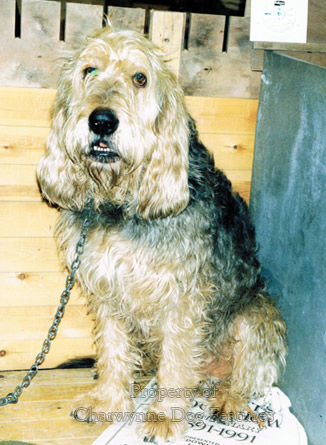
But, for me, far far worse than badly-written or ill-conceived breed standards on ears, is the odious and disgraceful practice of ear-cropping. This mutilation is still permitted in the USA and in some European countries, being banned in the UK, Norway, Finland, Sweden, New Zealand, Australia and some others. It is a classic example of humans imposing their cosmetic whims on dog. It causes great pain and shock and is completely unnatural. Unlike docking it cannot be done before the pup's eyes are open and indicates to me human indifference to dog's best interests. It is appallingly cruel and tells you more about some dog-fanciers' attitude towards their dogs than mere words could ever convey. We should all strive to achieve a world-wide ban on this shameful practice.
Just as unacceptable to me is the practice of branding hounds and 'rounding' their ears with hot irons. The much-quoted 'Stonehenge' in his 'The Dog in Health and Disease' of 1867, recorded that: "The small rounded ear of the foxhound is due to the rounding irons of the huntsman, who removes a large portion of the pup's ears in order to save them from the tears and scratches which they would inevitably encounter..." The French scenthounds however don't seem to suffer in the hunting field with their pendulous ears. If you want your hounds to have small ears, why not breed for it? Stonehenge pointed out that: "...in hounds it is usual to defer it till they are nearly full grown, as they often lose a considerable quantity of blood, which interferes with their growth."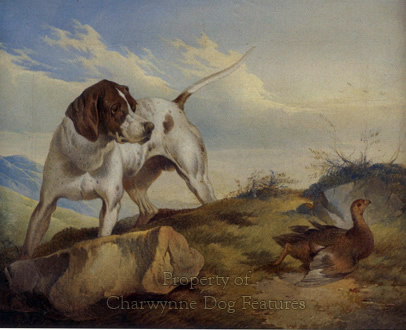
Stonehenge went to on to mention hounds being branded with hot irons shaped to the initials of the master or the hunt, going to state: "Both cropping and rounding require practice to perform them well, a large sharp pair of scissors being used...Some people after cutting one ear lay the piece removed on the other, and so mark exactly the amount which is to be removed from it..." There is no mention of anaesthetics in the spine-chilling coldness of these words. Dalziel, in his 'British Dogs' of 1888, described the pain involved in ear-rounding as 'trivial'; an attitude of the times no doubt but not one found in more enlightened times.
Geneticists tell us much about the inheritance of ear carriage but strangely overlook the clear tendency for long ears in a breed to get longer with each generation. This despite the weight of empirical evidence to demonstrate this fact. The research of Iljin (1937) tells us that semi-erect 'terrier' ears are completely dominant to lop 'hound' and erect ears. Marchlewski (1930) found that the small ear size of the German Shepherd was dominant to the large ear size of the Pointer, and the small triangular ear of the English Pointer dominant over the larger ear of the German Pointer. Pendant ears seem to dominate other ear-carriage types in crosses. Hauck (1949) found that there was no relationship between ear size and the degree of erectness in the ear.
The length of a dog's head is an inherited character which is almost as variable as the length of the dog's ears. Each breed has a relationship between the lengths of the dog's legs, its body, its head, its muzzle and its ears. Far better surely, in breed standards, to describe these proportions in relation to each other and the limits desired. In the standard of the Cocker Spaniel, for example, the ears are required to extend to the nose tip. Overlong ears, getting longer with each generation, are of no benefit to the dog. Why not state that the Cocker Spaniel's ears should extend to the nose but no further? Breeders and judges would then know that excessive ear length was frowned on in the standard. This was in fact the wording of the early breed standard and it was not wise to change it.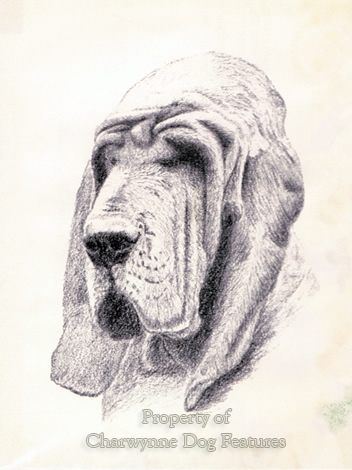
It is just not good enough to state that a scenthound's ears should be "long" or "very long" or that they should extend at least to the hound's nose. Basset Hounds which step on their own ears are handicapped animals. There is a health handicap too in overlong ears. The thick, heavy, low-set ears cut off the circulation of air in the ear canal, thereby providing a breeding ground for bacteria and yeasts which cause chronic ear infections. A very hairy ear canal further restricts air circulation. Disappointingly, hair in the ear canal is not mentioned in any breed standard. The KC/BVA working committee has plenty of work to do--if the will is there.
The European Convention for the Protection of Pet Animals (ETS 125) was adopted five years ago. Parties to this convention are asked to look at the breeding of animals with exaggerations, including those with very long ears. Three breeds are specified: the 'English' Cocker Spaniel, the Basset Hound and the Bloodhound. I am not altogether in favour of European interference in British affairs but on this occasion I feel that they have a point. Breeds of dog are man-made; man must therefore take responsibility for the end-product of his actions. How much better to put your own house in order before you are shamed into doing so by an outside body.
There are times when 'the state of the breed' needs to be explored by breed clubs. When breed features exaggerate themselves to a degree that is harmful to the dogs themselves, then surely even on purely moral grounds there is a pressing case for a review. To those who argue that breed type will be threatened by such a review I would say look at the breed a century ago, you have already lost true breed type. Breeders who perpetuate exaggerated stock to a degree harmful to the dog abrogate their right to be called breed-lovers. They are breed exploiters. How humiliating when those outside a breed speak up for the well-being of a breed whilst those inside say nothing. It's time for the KC/BVA Committee to say something.